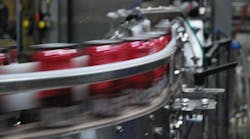How Downeast Cider House implemented MES to optimize use of its tanks, robot, palletizer, twist-rinse can line, filler and seamer machinery
Boston’s Downeast Cider House produces 36 blends or flavors of hard cider, half of them seasonal or limited stock-keeping units (SKUs). The cidery also distributes mix packs and a variety of units that give it a robust offering. “In total, we have about 76 different SKUs,” says Grainger Flint head of production and supply chain at the facility. “It's a lot to handle. When I was purchasing all the ingredients within Google Sheets, it was incredibly difficult to know what we had on hand, as well as how many I needed to purchase. We have about 300 to 400 raw materials that we need to buy to cover all of our items and all of our blends.”
The waterfront operation includes fermentation tanks, a Fanuc robot, TopTier palletizer, twist-rinse can line, filler and seamer machine.
After growing the business for more than 10 years with Google Sheets to manage production, Flint’s predecessor decided it was time to upgrade. After looking at enterprise-resource-planning (ERP) systems such as SAP and NetSuite, Downeast, with the help of Pat Welsh, director of manufacturing ERP consulting at the Revolution Group (Rev) in Columbus, Ohio, chose Plex Smart Manufacturing Platform from Rockwell Automation.
Being able to track materials within Plex in one serialized and central location makes production incredibly easy, explains Flint. “I now know what inventory we have on hand at any time, both here in-house, as well as our offsite warehousing partners. We have an offsite warehouse that handles all of our outbound finished-goods shipments. That's also integrated within Plex. We're able to see the inventory, and they're able to work with us on all of our outbound shipments from here, as well as handling all of our customer shipments out of that location.”
An accounts-receivable invoice is created the moment the truck leaves the warehouse. “That is our favorite part because then we get paid,” says Flint. “We were using Google Sheets for all 11 years before Plex. And it worked for us as a small business. But now, as a growing business, it's a little bit different.”
With the Plex system, operators are able to look at a human-machine interface (HMI) whenever they're trying to record production. “We're looking at our work center, which is our canning line, and, within the dashboard, you get to see what job is running,” explains Flint. “One really cool thing about Plex is we're able to utilize a multi-out dynamic production portion, so we can run two jobs at the same time.” In effect, it can create a work-in-progress (WIP) product, as well as the finished goods on the canning line.
“We have our jobs loaded. We have our operator loaded, and we have our work center status,” explains Flint. “We're able to click in to record production. Within the screen, you can see your targets for both jobs. You can also see our source material. We need to load material before we're able to print a tag. We can then start new containers and be able to record production each and every time a pallet comes out.”
The system is very intuitive for operators, notes Flint. “They're able to see the red stop light or green, which means we’re good to go,” explains Flint. “If we’re running low on materials, we need to load materials before we can record production. Right now, we're running 24 hour four-day-a-week production. Next year, we'll run a 24-hour production five days a week. We were originally in four-day-a-week 16-hour shifts. And then, as soon as we kicked off Plex, we went to 24-hour production that same day. It made it a little bit more interesting.”
Downeast’s biggest bottleneck is having a single can line, so it’s next process improvement will be either looking for ways to integrate new technology into the production line or utilizing Plex to plan production runs better so they're more efficient and yield more final product each day. “We're in a very small facility,” admits Flint, “so, at this point, we're just looking to see how much more we can squeeze out of here before making a larger investment.”





